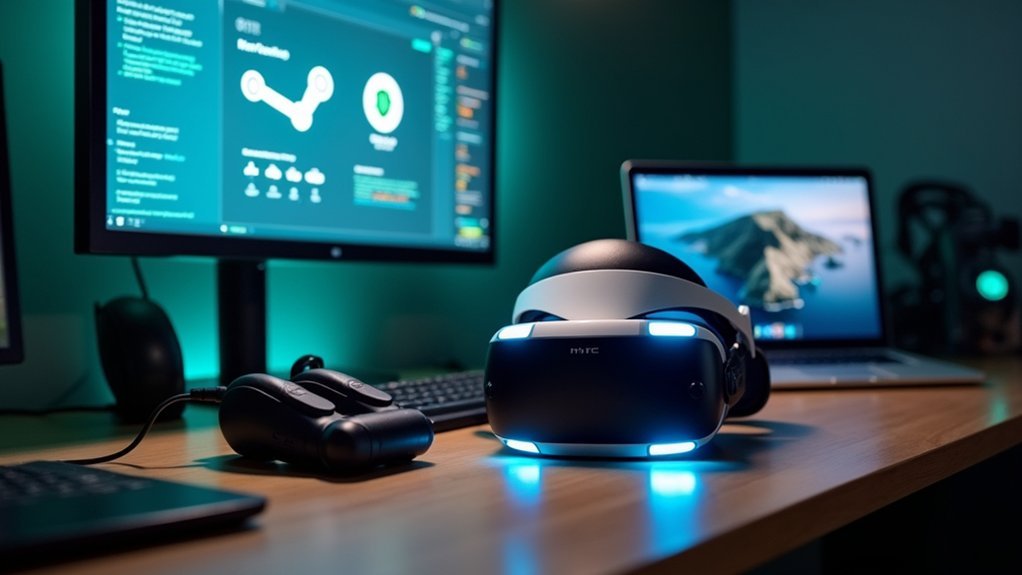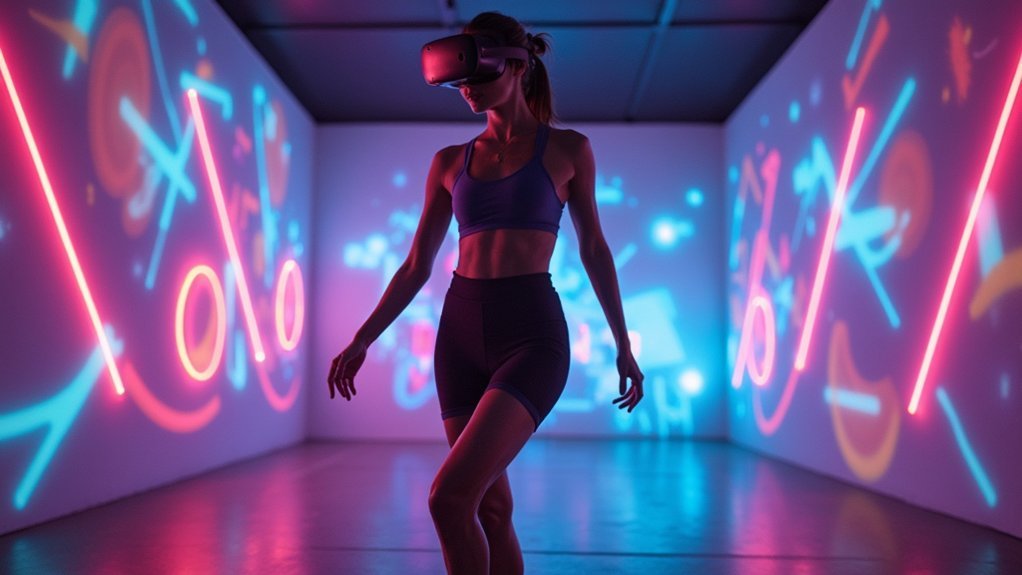You’ll find HTC Vive development resources through multiple SDKs including VIVE Wave for standalone devices, SteamVR for PC platforms, and OpenXR for cross-platform compatibility. You’ll need a high-performance gaming PC, proper Base Station setup with 15×15 feet tracking space, and development tools integrated with Unity or Unreal Engine. You can access documentation, tutorials, community forums, and distribution through VIVEPORT store for extensive VR development support and guidance.
Essential SDK Components and Documentation

Where do you begin when diving into HTC Vive development? You’ll need the right SDK components and thorough documentation to build successful VR experiences.
The VIVE WAVE SDK provides specialized tools tailored for HTC devices, complete with tutorials that’ll guide you through content development. For broader compatibility, the SteamVR SDK offers essential APIs for tracking, rendering, and input handling, plus sample code to accelerate your learning curve.
OpenXR takes portability further, letting you create content that works across multiple XR platforms without extensive porting. HTC’s VIVE hardware has passed conformance tests, ensuring reliable OpenXR support.
Each SDK comes with detailed documentation covering setup, integration, and advanced features. You’ll find detailed guides for the XR Elite specifically, helping you leverage its unique capabilities and maximize your development potential.
Development Environment Setup and Requirements
Before you can start building immersive VR experiences, you’ll need to establish a robust development environment that meets HTC Vive’s demanding performance requirements.
Your development environment setup begins with a high-performance gaming PC capable of delivering 2160 x 1200 resolution at 90 FPS. This specification guarantees smooth device optimization and seamless content development workflows.
High-performance gaming PCs delivering 2160 x 1200 at 90 FPS ensure optimal VR development workflows and seamless device optimization.
Essential setup requirements include:
- Spacious tracking area – Minimum 15×15 feet room with 120°H x 120°V coverage
- Strategic Base Station placement – Mount in opposite corners above head height
- Proper hardware connections – Link headset to PC via interface box and cables
- Obstacle-free environment – Remove reflective surfaces and physical barriers
You’ll need to carefully configure your physical space alongside your digital development tools.
The HTC Vive requires both technical specifications and environmental considerations for effective content development and testing phases.
Hardware Specifications and Tracking Capabilities
You’ll need to understand the HTC Vive Developer Kit’s core hardware specs to build effective VR experiences.
The headset delivers 2160 x 1200 pixel resolution across both eyes at 90 FPS, while its six degrees of freedom tracking system uses internal sensors combined with external Base Stations for precise movement detection.
Your tracking setup requires proper Base Station positioning to achieve the full 120° field coverage and maximize the available play space.
Display Resolution Standards
When developing VR applications for the HTC Vive, you’ll work with a display resolution of 2160 x 1200 pixels that delivers 1080 x 1200 per eye at 90 FPS. This specification guarantees your applications deliver immersive visuals that meet professional VR standards.
Understanding the HTC Vive’s display resolution helps you optimize your development process:
- Target Resolution: Design graphics and UI elements for 1080 x 1200 per eye to maximize visual clarity.
- Frame Rate Consistency: Maintain 90 FPS to prevent motion sickness and guarantee smooth user experiences.
- Performance Optimization: Balance visual quality with processing demands to meet hardware requirements.
- Quality Assurance: Test applications using the standard resolution to validate user comfort and engagement.
The display resolution works alongside superior tracking capabilities to create seamless VR experiences for your end users.
Six Degrees Freedom
The HTC Vive’s six degrees of freedom (6DoF) tracking system represents a breakthrough in VR technology, enabling you to move naturally through three-dimensional space with unprecedented precision.
You’ll experience seamless movement as internal sensors work with external Base Stations to deliver accurate positional tracking that minimizes simulator sickness.
The tracking system creates an immersive experience within a 120° field of view both horizontally and vertically.
You can utilize spaces up to 15 feet by 15 feet for peak performance, with tracking extending to 21 feet for larger environments.
This VR platform maintains consistent tracking fidelity even during rapid movements, thanks to laser-based sensors and advanced algorithms that define the six degrees of freedom standard for professional VR development.
Base Station Setup
Base Stations form the cornerstone of the HTC Vive’s room-scale VR tracking system, delivering the precise positioning data that makes 6DoF movement possible.
These Lighthouse sensors create an invisible tracking grid throughout your play space, enabling natural movement and interaction within virtual environments.
For ideal setup, you’ll need to position your Base Stations strategically:
- Mount above head height in opposite corners of your room to maximize coverage
- Ensure 120° horizontal and vertical coverage with up to 21 feet effective range
- Maintain clear line-of-sight between Base Stations and headset to prevent occlusion
- Allocate minimum 15×15 feet room space for unrestricted movement
The wireless operation simplifies installation while their quieter, compact design reduces distractions.
Proper Base Station placement directly impacts tracking performance, making thoughtful setup essential for immersive room-scale VR experiences.
SteamVR Integration and OpenXR Support

Since modern VR development demands cross-platform compatibility, you’ll find that integrating SteamVR and OpenXR support becomes essential for reaching the widest possible audience with your HTC Vive applications.
The SteamVR SDK provides extensive tools and APIs specifically designed for HTC Vive and compatible devices, while OpenXR delivers broader hardware portability across different VR platforms.
You’ll benefit from native integration support in Unity and Unreal Engine, streamlining your development process considerably.
For Vive Focus 3 projects, consider the VIVE Wave SDK for ideal performance, though OpenXR offers wider compatibility.
While OpenXR may present occasional performance challenges, its cross-platform advantages often outweigh these limitations.
Engage with community forums regularly to troubleshoot integration issues and share insights with fellow developers working on similar projects.
VIVE Wave Platform and Mobile VR Development
When developing mobile VR applications for standalone devices, you’ll discover that the VIVE Wave platform offers an open toolset specifically engineered for high-performance optimization.
This extensive SDK targets devices like the VIVE Focus 3, empowering you to create sophisticated VR content development experiences on mobile platforms.
The platform provides essential resources for effective implementation:
Essential resources streamline VR development implementation through comprehensive documentation, optimized code samples, and specialized tools for maximum efficiency.
- Thorough documentation and tutorials that streamline your VR content development workflow
- Sample code and best practices for optimizing mobile VR applications performance
- Device-specific optimization tools tailored for standalone devices like VIVE Focus
- Community collaboration features where you can share insights and troubleshooting solutions
You’ll benefit from the platform’s focus on mobile VR applications, accessing specialized tools that maximize your development efficiency while maintaining high-performance standards across VIVE Wave-supported devices.
Distribution Channels and Content Publishing
Once you’ve completed your VR application development, you’ll need efficient pathways to reach your target audience through VIVEPORT’s extensive distribution ecosystem.
The VIVEPORT store provides developers with self-service console tools that streamline content submission and performance monitoring processes. You’ll benefit from thorough documentation and store guidelines that help navigate the distribution landscape effectively.
The platform’s SDKs enable seamless integration for content distribution, allowing you to reach global audiences with your VR creations.
VIVE encourages developers to leverage these publishing resources for monetizing their applications within the store ecosystem. You’ll have access to effective content management tools that facilitate ongoing engagement opportunities, ensuring your VR experiences connect with wider audiences while maintaining streamlined operational workflows throughout the publishing process.
Community Resources and Developer Support
You’ll find extensive community resources and developer support when working with HTC Vive development kits.
The developer forum communities provide spaces where you can share insights, troubleshoot issues, and get advice from both peers and VR experts.
You’ll also have access to dedicated technical support channels staffed by HTC’s specialized team who can guide you through technical challenges and best practices for VR content creation.
Developer Forum Communities
Developer forum communities serve as essential hubs where you can connect with fellow HTC Vive developers, share insights, and troubleshoot complex development challenges.
The HTC Vive developer community forum provides dedicated sections where you’ll find targeted discussions and expert guidance.
Here’s what you’ll discover within these developer forum communities:
- Specialized Discussion Areas – Access dedicated sections covering performance optimization, content creation, and hardware integration topics.
- Collaborative Knowledge Sharing – Connect with both newcomers and seasoned developers in a supportive environment that encourages collaboration.
- Official Updates and Announcements – Stay informed about SDK releases, new features, and upcoming development events.
- Direct Support Team Access – Receive expert guidance from HTC’s support team for your development-related queries and technical issues.
These communities foster continuous learning and problem-solving opportunities.
Technical Support Channels
When you encounter complex technical challenges during HTC Vive development, accessing the right support channels can make the difference between prolonged troubleshooting and swift resolution.
HTC’s dedicated support team stands ready to assist you with technical queries, offering expert guidance on optimizing your applications for VIVE devices. You’ll find thorough help through multiple avenues, including direct technical support and community-driven solutions.
The developer forums serve as your primary hub for peer-to-peer assistance, where experienced developers share solutions and troubleshooting strategies.
Beyond community support, HTC provides official technical documentation through VIVE WAVE and OpenXR platforms, complete with tutorials and implementation guides.
Regular SDK updates and announcements keep you informed about new features and best practices, ensuring your development process remains current and efficient.
Frequently Asked Questions
What Software Does the HTC Vive Use?
You’ll use SteamVR SDK for core VR functionality, VIVE WAVE SDK for Focus devices, OpenXR for cross-platform development, Unity or Unreal Engine for content creation, and VIVEPORT Store SDK for distribution.
Why Was the HTC Vive Discontinued?
You’ll find the HTC Vive was discontinued because it couldn’t compete with newer headsets, declining sales hurt market share, and HTC shifted focus toward enterprise solutions and standalone VR hardware instead.
What Does a HTC Vive Come With?
You’ll receive a VR headset with 2160×1200 resolution, two base stations for room tracking, two motion controllers with 4-hour batteries, connecting cables, an interface box, and setup instructions.
What Do You Need to Run a HTC Vive?
You’ll need a high-performance gaming PC with a compatible graphics card, powerful processor, and sufficient RAM. You’ll also require at least fifteen feet by fifteen feet of room space for tracking.





Leave a Reply